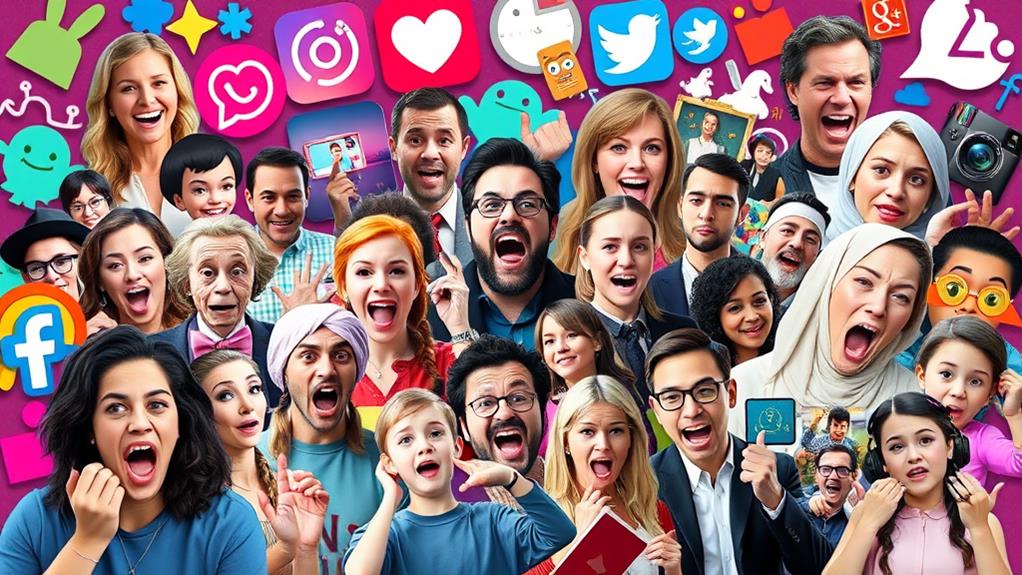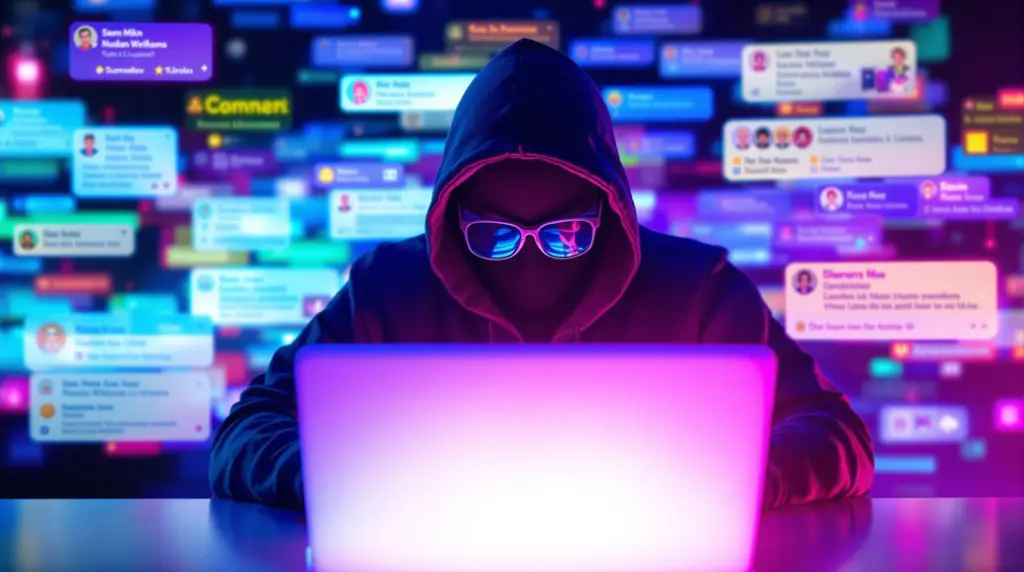To boost engagement across multiple social media platforms, focus on content types such as short-form video—preferred by 66% of users—and live video, which 37% of consumers find most engaging. Visual content, including high-quality images and shareable memes, can captivate 61% of users and drive considerable interaction. User-generated content also plays a critical role, influencing 80% of consumers in their purchase decisions. Text-based posts, complemented by engaging headlines and interactive elements like polls, further deepen customer relationships. Exploring these content types will reveal strategies for maximizing engagement and strengthening your brand presence.
Key Takeaways
- Short-form videos (5 seconds to 3 minutes) on TikTok and Instagram Reels are highly engaging and effective for brand promotion.
- Live video streams on platforms like Facebook and YouTube provide real-time interaction, enhancing visibility and customer relationships.
- High-quality images engage 61% of consumers, driving traffic and reinforcing brand identity, especially on Instagram.
- User-generated content (UGC) on Instagram and Facebook boosts engagement rates and fosters community connection.
- Memes and GIFs enhance brand relatability and shareability, particularly among younger audiences, driving immediate interaction and visibility.
Short-Form Video
Short-form video, defined as video content lasting between 5 seconds and 3 minutes, has emerged as a dominant force in capturing audience attention swiftly and effectively.
Platforms like TikTok and Instagram Reels have become the epicenter for these videos, with TikTok alone achieving a staggering 15 billion daily views.
Data indicates that consumers find short-form videos 2.5 times more engaging than their long-form counterparts, with 66% of users stating they are the most enchanting content type available.
Social media algorithms favor short-form videos, enhancing their visibility and reinforcing their role as a powerful tool for brand promotion.
This visibility makes them particularly effective for brands aiming to maximize engagement potential.
By leveraging trending topics and incorporating creative storytelling techniques, brands can utilize short-form videos for product showcases, tutorials, and influencer collaborations.
These videos not only capture immediate attention but also maintain audience engagement, making them highly effective in driving consumer interaction.
Images
While short-form videos have revolutionized audience engagement, images remain a cornerstone of effective social media strategies. According to recent data, images are the second most valuable content type across social networks, with 61% of consumers finding them engaging and likely to drive interaction. This enduring appeal is fueled by high-definition cameras and sophisticated editing tools that enable brands to produce high-quality visuals, consequently capturing audience attention effectively.
Embracing mobile design principles can additionally optimize image content for small screens, ensuring higher engagement on mobile devices.
Instagram stands out as a pivotal platform for image-based content, with 87% of its content being image-centric. Brands leveraging image optimization techniques can greatly enhance their reach and engagement on this platform.
Moreover, engaging visuals, such as trend-driven Pins on Pinterest and shoppable feeds on Instagram, are instrumental in driving traffic and inspiring purchases, thereby reinforcing brand identity.
Posts featuring well-crafted visuals tend to receive more clicks, shares, and comments, underscoring the importance of incorporating a diverse mix of photos, text overlay images, and videos into social media strategies.
Live Video
Live video content is rapidly transforming the landscape of social media engagement, with 37% of consumers rating it as the most engaging content type available. By fostering real-time interaction and authenticity, live streaming has become an indispensable tool for brands aiming to connect deeply with their audience.
Platforms such as Facebook Live, Instagram Live, YouTube Live, and LinkedIn Live are at the forefront of this trend, offering robust features to enhance community building and audience interaction. Brands can increase their audience retention by ensuring high-quality visuals and audio during live streams.
Brands seeking to leverage live video can capitalize on several key strategies:
- Showcasing Events: Live streaming events or product launches provide a dynamic way to capture audience attention and generate buzz.
- Q&A Sessions: These sessions allow for immediate audience feedback and interaction, addressing questions and concerns in real-time.
- Content Repurposing: Post-broadcast, brands can create shorter clips from live sessions to extend reach and sustain engagement.
Engaging in live sessions not only boosts visibility but also strengthens customer relationships. The immediacy of live streaming offers a unique opportunity for brands to showcase transparency and authenticity, thereby fostering trust and loyalty.
User-Generated Content
User-Generated Content (UGC) greatly enhances authenticity and fosters trust, with 80% of consumers influenced by peer-generated content in their purchase decisions.
Platforms like Instagram, YouTube, and Facebook effectively showcase UGC, bolstering community engagement and brand loyalty. Brands incorporating UGC not only experience higher engagement rates but also benefit from reduced content production costs and increased audience participation, as evidenced by successful campaigns like L'Oreal Paris's TikTok contest.
Additionally, engaging with UGC can increase visibility and encourage reciprocal engagement, cultivating a vibrant community around the brand.
Peer-Generated Content Benefits
Leveraging user-generated content (UGC) has become a vital strategy for many brands aiming to boost engagement and build trust with their audience. UGC is perceived as more credible than traditional advertising, with 80% of consumers influenced by UGC in their purchase decisions. This credibility stems from several factors, most importantly the trust signals and authenticity factors inherent in peer-generated content.
Key Benefits of Peer-Generated Content:
- Enhanced Credibility: UGC acts as a powerful trust signal, making brands appear more authentic and reliable. This is essential in an era where consumers are increasingly skeptical of traditional advertising.
- Increased Engagement: Brands leveraging UGC often see heightened interaction, as it fosters a sense of community and encourages audience participation. For example, L'Oreal Paris's TikTok contest appreciably boosted brand awareness and organic reach.
- Cost-Effective Marketing: By relying on customers to create content, brands can lower production costs. Platforms like Instagram, YouTube, and Facebook are particularly effective for showcasing UGC, further enhancing brand authenticity and trust among consumers.
Building Community Trust
How can brands effectively build community trust in an increasingly digital world? Leveraging user-generated content (UGC) is a powerful strategy to enhance brand authenticity and foster community involvement. Data reveals that 80% of consumers are influenced by UGC in their purchasing decisions, perceiving it as more authentic than traditional advertising. This authenticity is essential for building trust.
Brands that incorporate UGC into their marketing strategies often see higher engagement rates. In fact, 79% of marketers planned to invest more in video content featuring user-generated elements in 2023. Platforms such as Instagram, YouTube, and Facebook are particularly effective for showcasing UGC, creating a space for community engagement and trust-building.
Moreover, UGC can greatly reduce marketing costs by utilizing real customers to create content, eliminating the need for expensive production resources. Successful campaigns, like Apple's #ShotoniPhone, not only build a sense of community but also turn customers into brand advocates, thereby strengthening long-term loyalty.
| Platform | Engagement Rate Increase | Cost Reduction |
|---|---|---|
| High | Moderate | |
| YouTube | Moderate | High |
| High | Moderate |
GIFs and Memes

GIFs and memes have become powerful tools for brands aiming to boost engagement, particularly among younger audiences who appreciate humor and cultural references.
With over one million meme shares on Instagram daily, these formats not only drive considerable interaction but also foster immediate connections and encourage widespread sharing.
By leveraging trending memes, brands can enhance relatability and participate in broader conversations, thereby increasing their visibility and relevance.
Additionally, memes can considerably enhance social proof, making them an essential part of any UGC strategy.
Humor Drives Audience Connection
Although humor has long been a cornerstone of human interaction, its integration into digital marketing through GIFs and memes has proven particularly effective in engaging modern audiences.
Meme marketing leverages comedic timing and cultural relevance to create immediate connections with audiences, particularly younger generations. This form of content resonates deeply, driving over one million shares daily on Instagram and enhancing brand relatability.
Brands that excel in meme marketing often see a significant uptick in engagement rates. Here are three reasons why:
- Instant Interaction: Humorous content encourages immediate reactions and shares, making it a potent tool for quick engagement.
- Cultural Commentary: Memes often reflect current trends and events, allowing brands to position themselves as timely and relevant.
- Emotional Connection: GIFs provide a fast, entertaining way to convey emotions, boosting audience relatability.
ProWritingAid is a prime example of how memes can foster community engagement and brand loyalty by addressing relatable writing experiences.
The fusion of humor with strategic content planning makes GIFs and memes indispensable in modern social media strategies. By understanding and utilizing these elements, brands can cultivate a more engaged and connected audience.
Shareable, Relatable Content
Incorporating shareable, relatable content such as GIFs and memes can considerably amplify brand engagement, particularly among younger demographics. Memes alone generate over one million shares daily on Instagram, highlighting their effectiveness in boosting brand relatability and engagement.
The cultural relevance of memes and GIFs makes them an ideal medium for brands aiming to resonate with audiences seeking entertaining content. Utilizing humor in these formats fosters immediate interaction and sharing, thus enhancing emotional resonance with the audience.
Brands can strategically leverage trending and topical memes to integrate into broader conversations, thus amplifying their relevance and visibility across multiple social media platforms. For instance, ProWritingAid employs memes to address relatable writing experiences, which not only cultivates community engagement but also strengthens brand connections.
Engaging with GIFs and memes not only broadens potential reach but also enables brands to communicate ideas swiftly and efficiently. This quick communication enriches audience interaction and solidifies the brand's presence within the cultural zeitgeist.
As a result, integrating these shareable, relatable content types into social media strategies is essential for brands aiming to enhance engagement and connect meaningfully with their audience.
Text-Based Posts
Text-Based Posts
Text-based posts play an essential role in social media strategies, engaging 32% of consumers and proving to be a powerful tool for fostering deeper customer relationships. These posts leverage the power of alluring headlines and storytelling techniques to create a meaningful connection with the audience.
Additionally, high-quality visuals can complement text-based content, making posts more appealing and engaging. Incorporating interactive elements like polls and quizzes within text-based posts can also increase engagement rates.
To maximize the impact of text-based posts, brands should focus on the following strategies:
- Engaging Captions: Use numbers, promise benefits, and convey urgency to enhance interaction and click-through rates.
- Optimize for Platforms: Tailor posts to fit each platform's character limits and features, guaranteeing maximum visibility and engagement.
- Consistent Brand Voice: Maintain creativity and consistency to establish and reinforce a distinct brand voice that resonates with your audience.
The key to successful text-based posts lies in balancing visual content with the power of words. This approach not only initiates conversations but also deepens customer relationships by engaging them on a more personal level.
Frequently Asked Questions
What Content Works Best on Different Social Media Platforms?
Short-form videos excel on TikTok and Instagram Reels, while high-quality visuals thrive on Instagram and Pinterest. User-generated content enhances brand credibility on YouTube and Instagram, and live videos drive engagement on Facebook and Instagram.
What Content Works Best on Different Social Media Platforms?
Short-form videos and images excel in visual storytelling, while live sessions and interactive polls enhance real-time engagement. User-generated content boosts credibility, and text-based posts deepen relationships, catering to diverse audience preferences across platforms.
What Content Gets the Most Engagement on Social Media?
Visual storytelling, particularly through short-form videos and images, garners the highest engagement on social media. Interactive posts, including live videos and user-generated content, also greatly boost engagement, driven by authenticity and audience participation.
How Do You Tailor Content for Different Social Media Platforms?
To tailor content for different social media platforms, analyze audience demographics and platform algorithms. Adapting content to these factors guarantees higher engagement, leveraging data-driven insights to meet audience preferences and optimize reach across diverse networks.
Conclusion
In summary, maximizing engagement across multiple social media platforms necessitates the strategic use of various content types. Short-form videos, images, live videos, user-generated content, GIFs, memes, and text-based posts each play an essential role in capturing audience attention and driving interaction. Data indicates that these diverse formats cater to different user preferences and consumption habits, underscoring the importance of a multifaceted content approach to maintain relevance and foster sustained engagement in a rapidly evolving digital landscape.




